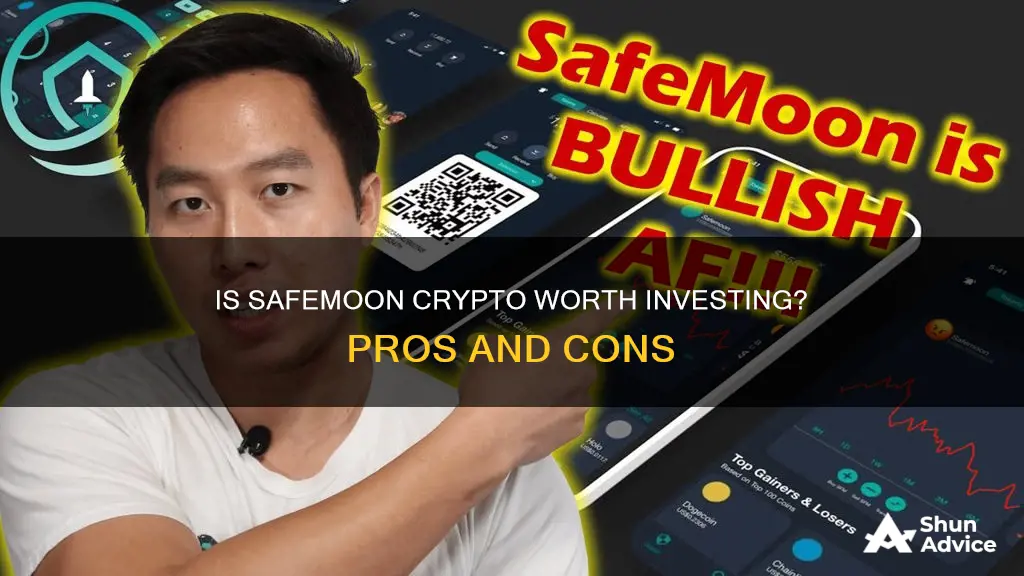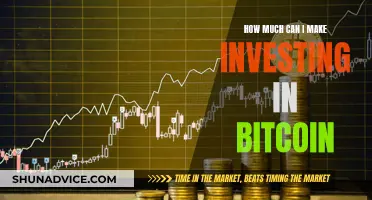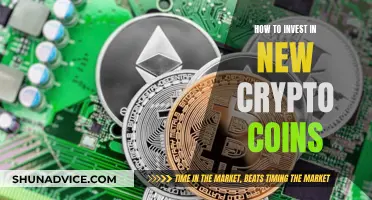
SafeMoon is a relatively new cryptocurrency that has gained a lot of attention for its massive gains and unique fee structure. It was launched in March 2021 with a supply of 777 trillion tokens, each priced at a fraction of a cent. SafeMoon charges a 10% fee for selling tokens, with half of the fee redistributed to existing holders and the other half used for a liquidity pool. This fee structure is designed to reward long-term investors and reduce price volatility. However, SafeMoon has been criticised for its lack of real-world utility, extreme volatility, and security concerns. Some analysts even believe it to be a pump-and-dump scheme. With these factors in mind, is SafeMoon a good investment?
| Characteristics | Values |
|---|---|
| Current Price | $0.0000005866 |
| Market Cap | $330 million |
| Purpose | To get people to buy and drive the price up |
| Supply | 777 trillion tokens |
| Fee for Selling | 10% |
| Fee Distribution | 5% to existing holders, 5% to a liquidity pool |
| Passive Income | Yes |
| Volatility | High |
| Illiquidity | Yes |
| Utility | No |
| Influencers | Dave Portnoy, Jake Paul |
| Ownership | Centralized |
| Risk | High |
What You'll Learn

Safemoon's high-risk, high-reward nature
Safemoon is a high-risk, high-reward cryptocurrency investment. Its low price and promise of high returns have made it popular with investors looking for the next big altcoin.
The high-risk nature of Safemoon is due to several factors. Firstly, it is a relatively new cryptocurrency, having launched in March 2021. This means there is limited historical data to assess its performance and potential. Secondly, Safemoon is not listed on major cryptocurrency exchanges, so most buyers acquire it on decentralised exchanges like PancakeSwap. This makes it less liquid and more volatile than other cryptocurrencies. Thirdly, Safemoon does not have any real-world utility or competitive advantage over other cryptos in terms of transaction speed, security, or other features. It is also not accepted by major vendors as a payment method and is difficult to trade for fiat currencies or other cryptocurrencies.
Adding to the risk is the fact that Safemoon charges a 10% fee for selling, with half of that fee redistributed to existing holders and the other half used for a liquidity pool. While this is designed to reward long-term holders and stabilise the price, it also makes Safemoon extremely illiquid. Furthermore, an audit by security platform CertiK found a major issue with the liquidity pool, as an owner address will acquire the tokens generated by the Safemoon-BNB pool, giving the owner control over tokens funded by Safemoon's seller fee.
Another concern is the centralised ownership of Safemoon. Its CEO reportedly owns more than 50% of the coin's liquidity, and insiders are generating a large amount of passive income. This has led to comparisons with Bitconnect, a cryptocurrency that collapsed amid fraud accusations.
Despite the risks, there are some potential rewards for investing in Safemoon. The cryptocurrency has gained a loyal group of early investors and has regularly been trending on social media, indicating a strong brand. The manual burning of tokens is also intended to increase the price over time by reducing supply. Additionally, the high fees for selling can generate passive income for investors who hold Safemoon over the long term.
In conclusion, Safemoon is a high-risk, high-reward investment. While it has some attractive features, there are also significant concerns about its long-term viability and potential for price manipulation.
Understanding Taxable Interest as Investment Value
You may want to see also

The 10% fee for selling
One of the most unique features of Safemoon is the 10% fee charged for selling the cryptocurrency. This fee is designed to encourage investors to hold their tokens for the long term, reducing price volatility.
The 10% fee is distributed as follows: 5% is redistributed to existing holders, and the remaining 5% is split equally, with half being converted to Binance Coin (BNB) and the other half remaining as Safemoon tokens. These tokens are then paired and used in a liquidity pool. This fee structure incentivises long-term investing and discourages selling, with the goal of stabilising the price.
However, an audit by security platform CertiK revealed a major issue with this fee structure. They found that an owner address will acquire the liquidity pool tokens generated by the Safemoon-BNB pool, giving the owner control over tokens funded by the Safemoon seller fee. This has raised concerns about centralised ownership and the potential for a Ponzi scheme.
Strategic Bitcoin Investment: Tips for Success
You may want to see also

Passive income for investors
SafeMoon is a source of passive income for investors. It was created to incentivize long-term investing and discourage selling. Every SafeMoon transaction incurs a 10% fee. 5% of this fee is redistributed to SafeMoon holders, and the remaining 5% is split between Binance Coin and added to PancakeSwap's liquidity pool. SafeMoon investors can gain passive income through these incentives, but they have to pay a 10% fee if they want to sell.
SafeMoon's static reward approach attempts to mitigate the problem of early adopters selling their coins en masse. The reward amount is conditional upon the volume being traded, which mitigates selling pressure caused by early adopters selling their coins. It encourages those holding the tokens to collect higher payments based on the total number owned.
Staking is another way to make passive income from crypto investments. It works similarly to a savings account that pays interest. You can stake a portion or all of your cryptocurrency holdings (with a token that allows it) for a percentage-rate return on the investment. Returns are usually paid in the native token, and even the biggest crypto tokens offer staking pools to new investors.
Rewards tokens are cryptocurrencies that pay out a reward to coin holders. Like staking, it's a means for investors to watch their initial deposit grow. However, rewards are paid out regardless of entering into a staking contract. This can reduce the risk of your investment, but you may also earn less money depending on the rewards policies.
With top rewards tokens like SafeMoon, rewards are paid out in the native SAFEMOON token. The SafeMoon protocol pays out rewards proportionally to the size of your holdings. The Annual Percentage Yield (APY) is dictated by trading volume, so it can vary depending on how many people are trading that token each day.
Physical Bitcoins: Worthwhile Investment or Novelty Item?
You may want to see also

Lack of real-world utility
SafeMoon is a relatively new cryptocurrency, having been created in March 2021. It has gained attention for its high-risk, high-reward nature, and its unique fee structure. However, one of the biggest drawbacks of SafeMoon is its lack of real-world utility.
Firstly, SafeMoon has no major vendors that accept it as a payment method. This is a significant issue as it limits the practical use of the cryptocurrency in everyday transactions. SafeMoon also does not have a technological advantage over other cryptos in terms of transaction speed, security, or other features. This means that there is little incentive for businesses or individuals to adopt SafeMoon as a payment method, further reducing its real-world utility.
Secondly, SafeMoon is not traded on major centralized crypto exchanges such as Coinbase Global Inc. and Gemini. This makes it more difficult for investors to trade SafeMoon for fiat currencies or other cryptocurrencies. The only way to trade SafeMoon currently is by using Binance's PancakeSwap decentralized exchange. This lack of accessibility on major exchanges limits the liquidity of the SafeMoon market and makes it more difficult for potential investors to buy into the cryptocurrency.
Thirdly, SafeMoon has been criticized for its lack of a clear purpose or utility beyond getting people to buy and drive up the price. SafeMoon's website makes vague allusions to future plans, such as setting up a SafeMoon app, wallet, and video games, as well as "integrating SafeMoon with African markets." However, there are few concrete details about these plans, and it is unclear how SafeMoon will provide value or solve any real-world problems.
Finally, SafeMoon has been compared to a Ponzi scheme or pyramid scheme, where gains to early investors are paid only by incoming investors who expect similar returns. The fee structure of SafeMoon, which charges a 10% fee on transactions, with 5% redistributed to existing holders, has been cited as a reason for this comparison. This fee structure discourages investors from selling and can create a situation where the price is artificially inflated.
In conclusion, while SafeMoon has gained attention for its unique fee structure and high-risk, high-reward nature, it currently lacks real-world utility. It is not widely accepted as a payment method, is not traded on major exchanges, and has been criticized for its lack of a clear purpose beyond driving up the price. Therefore, potential investors should carefully consider the risks and lack of real-world utility before investing in SafeMoon.
VGX Coin: A Smart Investment Decision?
You may want to see also

Celebrity endorsements
Celebrities and influencers with millions of followers have endorsed the SafeMoon crypto token, including Jake Paul, Keemstar, Lil Yachty, Nick Carter, Soulja Boy, Logan Paul, and Ben Phillips. Daniel Keem, also known as Keemstar, has been particularly vocal about his support for SafeMoon on social media, tweeting about its potential for high returns.
SafeMoon has also been endorsed by celebrities outside of the influencer sphere, including musicians and athletes. Nick Carter, a member of the Backstreet Boys, supported SafeMoon in several tweets in April 2021. In addition, American football quarterback Tom Brady partnered with crypto exchange FTX in June 2021 and attended crypto events, including the four-day Crypto Bahamas event in April 2022.
These celebrity endorsements have not been without controversy. A group of investors filed a lawsuit in February 2022, alleging that SafeMoon used these celebrity endorsements to promote misleading claims about the potential for investors to profit. The lawsuit also claimed that SafeMoon was a pump-and-dump scheme, where early investors encourage others to buy and then sell their coins, driving the price back down.
SafeMoon's price has been volatile, and some analysts have expressed concerns about its long-term viability. Despite the endorsements and hype, SafeMoon's price has dropped significantly since its launch, and it has faced accusations of being a rug-pull or pump-and-dump scheme.
How to Buy Bitcoin via RBC Direct Investing?
You may want to see also
Frequently asked questions
SafeMoon is a community-driven cryptocurrency that launched in March 2021. It was designed to encourage investors not to sell and to reward those who buy and hold.
SafeMoon is considered a high-risk and speculative investment. It has been referred to as a Ponzi scheme, a pump and dump, and a pyramid scheme. It also has no real-world utility and is not accepted by major vendors as a payment method. There are also concerns about its centralization and security vulnerabilities.
SafeMoon has gained a lot of attention and has a loyal group of early investors. It also has the potential to generate passive income for investors as it charges a 10% fee for selling, half of which is distributed to existing holders.







